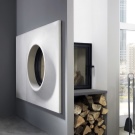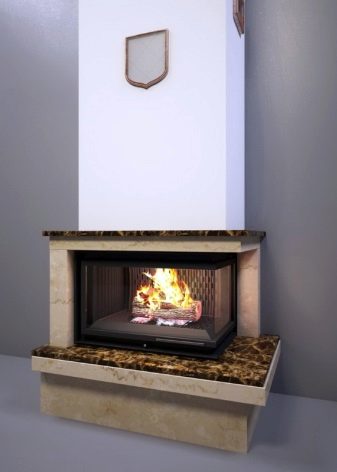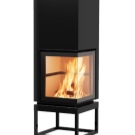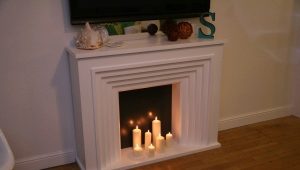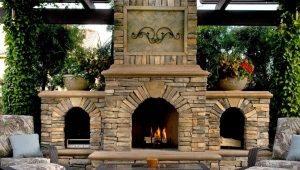Fireplace stove with a water heating circuit
You might think that a fireplace and an autonomous house heating system belong to different eras. At the beginning of the twentieth century, low efficiency and high fuel consumption led to the almost complete disappearance of a heating element such as a fireplace. But the attractiveness of the living flame and the chic appearance of the old fireplace did not allow people to forget about it, so manufacturers thought about improving the design and began to invent additional elements to increase its heat transfer. Such work on the combination of functional and decorative possibilities of fireplaces led to the appearance of a fireplace with a water circuit.
Design features
In the modern world, many would like to have an old fireplace in their homes, not only as a find for designers that enlivens the interior, but also as an excellent additional means of heating. This is a fireplace with built-in heat exchanger.
The initial duty of the fireplace has always been to heat the room in which it was installed. Over time, open fireplaces turned into stoves of a closed type, which made it possible to use them in almost any room, although it required constant maintenance and cleaning. The next step in improving the autonomous heating system at home was the emergence of solid fuel boilers supplying hot water to a radiator system. In the modern world, designers are increasingly paying attention not only to decorative qualities, but also to the functionality of a certain element of the interior. A solid fuel boiler does not look as elegant as a fireplace. That is why fireplaces equipped with a water heat exchanger, have proved very popular and in demand.
In fact, such a fireplace is a familiar solid fuel boiler, because it has a furnace for burning fuel. But it fits perfectly into the interior, especially in the case when its lower part is made in the form of a classic fireplace. Thus, for the uninitiated person, the fact that the beautiful element of the luxurious design of a country house performs the function of its heating remains completely incomprehensible.The main feature of this device is that it can be a source of hot water and home heating, or to supplement the dacha heating with an electric boiler or even solar panels.
Manufactured by the industrial method, the fireplace includes double walls, the distance between which is about 4 cm. This very space is a water circuit. It is called a heat exchanger in which water is heated. Heat from a burning wood in a fireplace stove heats the water through a heat exchanger, and then is transferred to water or other coolant to heat the house. In this case, the fireplace works in the same way as the boiler for heating with gas or electric heating.
After one portion of the water heats up and leaves the heat exchanger, the cooled water from the bottom pipe (“return”) will rise into the heat exchanger for heating. In this case, water circulates in portions as it is heated, this method of heating is called natural circulation. The operation of the heating system in this case depends only on the timely supply of fuel. This method of water circulation is called open,as it requires the presence of an open water tank installed at the highest point of the system and responsible for the presence of pressure in the water column.
Another type of water supply is connected to the connection to the heating system of the pump, which ensures the continuous circulation of water. This method is called closed, because in this case, water immediately enters the pipes and radiators of the heating system. This method of heating is less safe, since in case of a pump shutdown, overheating of the heat exchanger and an accident can occur due to a power cut. To avoid trouble, in this case, a country house should be equipped with an electric generator (diesel or gasoline operated).
Also, for greater security when installing a country house heating system, it is necessary to include both principles of operation in the heating scheme, that is, to take into account both the presence of a pump and its possible stop, and combine a closed heating system with an open one. As practice shows, it is the combination of closed and open systems that gives the best result.
Designers of modern fireplaces designed to work with heating systems,fuel combustion conditions have been improved to increase the efficiency of the fireplace and facilitate maintenance.
Usually, the fuel in the fireplace does not burn completely, this is due to the fact that in the pipes of simple fireplaces there was always a direct air draft, which literally pulled up to 80% of the fuel that did not have time to burn out. Hence the attitude to the fireplace, as a luxury item available only to the rich.
Nowadays, a metal wood “clean burning furnace” has been developed, which looks like a fireplace with a door made of transparent heat-resistant glass. Thanks to the door, it became possible to implement the principle of re-burning, in which a special device for slowing down the thrust, the so-called “tooth”, which, together with the additional air supply, leads to the re-ignition of unburned fuel particles is built into the fireplace design. Thereby, the fuel burns more fully, the heating of water in the contour of the fireplace increases and its performance increases.
Thus, the effectiveness of fire increases by 20%. It also reduces fouling and oxidation of the chimney (soot),which increases its durability. Cleaning and cleaning the fireplace becomes easier, and also reduces the amount of smoke several times. It is impossible to install such an afterburning system in a brick stove or in a fireplace without a door, as in such stoves there are no ways to control the movement of air flows.
Long burning mode. This option is invented by hunters who spend the night in the forest, and is currently used in fireplaces. In this case, the air flow is reduced, so that the wood is no longer burning, but smoldering. One tab of firewood is enough for almost 8 hours. Thus, the temperature is maintained longer and the fireplace does not require a constant supply of firewood.
Not all furnaces and chimneys are designed for a slow burning cycle. These are stoves - fireplaces manufactured by industry, equipped with pipes, and indicating in the characteristics, besides the fire modes, additional functions: smoldering or slow mode, which increases the combustion cycle.
A brick fireplace, which is designed to work continuously for 2 or 3 hours, cannot be converted to work for 8 hours.
Advantages and disadvantages
In a situation where it is impossible to provide gas or electric heating for a country house, you can use exactly the stove - a fireplace with a water heat exchanger.
The advantages of such a heating system is enough:
- Work on cheap and affordable type of fuel;
- The possibility of combining with other types of heating systems;
- The ability to provide the house with hot water for the bath and dishwashing (in the case of installing a double-circuit heat exchanger, both circuits in which are absolutely independent);
- The presence in the interior of a beautiful, romantic fireplace, around which you can gather on a cold evening;
- For some models - the presence of a cooking surface for cooking (stove - fireplace with stove).
Some owners may be repelled by the presence of flaws inherent in any type of fireplace, namely:
- In winter, such a fireplace should work constantly, accordingly, it should not be left unattended;
- Fireplace with a water circuit requires the supply of fuel in the "manual mode" (exception-fireplace-automatic, working on wood pellets - pellets);
- Extinguished fireplace cools down quickly enough, causing cooling of radiators and temperature drop in the room;
- There are certain limitations on the power of the device that you need to know when purchasing a fireplace.
How to do it yourself
If you intend to independently equip your country house with a stove - a fireplace with a water circuit, then carefully consider your capabilities and abilities.
There are many ready-made devices of this type, which can be bought in the assembled state, installed in a convenient location, connect the chimney and connect to the water heating system. It is necessary to install a special base for the installation of such a structure: the foundation and tiled around the fireplace area. The latter is especially necessary in the event that the floor in the house is wooden, as the small coals falling out of the fire chamber of the fireplace may cause a fire.
The stove - a fireplace when heated heats up, so you should not place it near other interior items, or close to wooden walls. Plus the fact that when heated such a furnace heats the room in which it is installed.
Typically, such furnaces have a transparent door of heat-resistant glass, through which you can admire the tongues of a burning flame.If necessary, such a device can be relocated to a new location without losing its performance.
You can also build an open fireplace with a brick water contour with your own hands that will last you a lifetime.
First you need to decide on the size of the fireplace and its permanent location, because a brick fireplace with a heat exchanger can not be transferred to a new place. The size of the fireplace should be commensurate with the height of the ceilings and the surrounding interior. Around the fireplace should be enough space so that you can accommodate all guests at home.
If you are an experienced builder, you do not need to limit yourself to choosing a design.
The main elements of an open fireplace with a water circuit:
- A solid foundation, which is poured from a concrete solution, or laid out of brick;
- Fire chamber with a contour of water heating;
- Portal with a recess under the furnace (which is then covered with stone or tiled lining);
- Chimney;
- Portal elements;
- The system connects to the heating.
Most structures use brick, which is the most economical material to create both the foundation and the skeleton of the fireplace.
Fireplace for the fireplace is selected with the calculation of its approximate performance and based on the size of the room. It is desirable to acquire a more powerful device, approximately with a margin of 25-30% of the required consumption.
Important design of the furnace and its type. There are corner and recessed inserts - liners, but they all require proper installation and subsequent lining.
All fireplace inserts with a water circuit provide heating not only for the heat carrier, but also for the surrounding space. This fact must be taken into account during installation and build a portal under the fireplace stove in exact accordance with the drawings specified in the documentation.
When creating a brick portal, it is imperative to use refractory ceramic bricks. Another option is to use foam blocks that are laid on fire resistant glue and reinforced by reinforcement.
The arrangement of the chimney must comply with fire safety standards, for which it is necessary to invite a specialist and obtain the necessary permits from the fire department.
To give the fireplace an attractive appearance and create a romantic atmosphere, the surface of the portal is covered with natural or artificial stone, tiles or tiles.
Connect a homemade fireplace with built-in water circuit should be very well, as this will largely depend on the effectiveness of its work.
Important conditions by which the water circuit will be protected from overheating:
- The creation of a so-called “security group” upon connection, which is necessary so that in case of an emergency increase in pressure in the system, it can be urgently lowered;
- Installation of a “submix unit” with an adjustment valve in order to redirect part of the hot water to another circuit, for example, to the “warm floor” system;
- Installing the expansion tank. In the case when the closed heating system is mounted, a membrane tank is installed to prevent the ingress of oxygen into the pipes. For open heating systems, an option is provided in the form of a tank built into the highest point of the system;
- The use of metal pipes when connecting elements of the heating system. Since water heating can reach its boiling point, pipes made of metal or PVC can become unusable. Metal pipes are the best choice. Copper pipes are an excellent choice, since they are durable and no internal deposits (rust) form on them.However, in this case, the use of brass adapters and copper radiators is mandatory, since it is unacceptable to mix when installing one system of copper and aluminum products, this can cause an accident.
Selection tips and reviews
In most cases, when choosing a fireplace with a heating circuit, buyers pay attention to the price and design. In this case, the real criteria for choosing such a fireplace should be:
- Its strength, power and safety;
- Duration of burning;
- Additional functions (for example, the function of slow combustion);
- Design and opportunity to save on price.
Both stand-alone stoves - fireplaces, and fireboxes - inserts can be made from either steel or cast iron. Steel products are not sensitive to temperature shocks and are not as heavy as cast iron. It should be remembered that cast iron is a rather fragile material that requires careful handling during installation and cannot be re-installed. Cast iron stoves - fireplaces are better than steel, retain heat and are more durable, respectively, higher in price.
A guarantee of the reliability of the device may be a well-known brand,as a manufacturer with a good reputation is necessarily interested in a high level of technical characteristics, as well as the safety of its products and gives a longer warranty. In most cases, such firms provide post-warranty service for their products.
Calculation of power is indicated in the product data sheet. It is always necessary to purchase heating appliances with a certain power margin.
Fireplaces equipped with heat-resistant glass doors are more economical and safer.
An additional advantage that can significantly simplify the maintenance of the furnace - a fireplace in the cold period, is the presence of a long-burning function, which must be indicated in the accompanying documentation.
Finished devices often have a built-in oven and a hob, but it’s impossible to place such a device in the living room precisely because of the pronounced “kitchen” design.
Fireplace - liner will be cheaper than a ready-made fireplace with a water heat exchanger, but the cost of building a portal for it and the subsequent lining will be required.
A fireplace with a built-in firebox - liner, undoubtedly, will look much more spectacular, it will bring the coziness and magic of a real old fireplace into the house. Such fireplaces look luxurious and do not give out the utilitarian features of their device.
You must be very thoughtful about the installation of a fireplace with a water heating circuit, since there are important details that you need to know and be sure to take into account, since this device is primarily a heating device and requires compliance with safety regulations.
Rating manufacturers who supply fireboxes - inserts for the fireplace with a water circuit and fully equipped fireplaces, headed by well-known German, Italian and French brands.
SchmiD Ekko fireplaces are considered super-elite, the company provides an opportunity to order a fireplace insert according to individual sizes, all wishes of the customer are taken into account, thus each owner is provided with space for imagination in creating an individual fireplace.
In user reviews, particular emphasis is placed on the pivotal function of the smoke collectors of this German company, which makes it possible to connect to the chimney at the most convenient angle.
All fireplace inserts are equipped with cladding material from the German company Camina, as well as marble portals made by Arriaga.
EdilKamin offers a fireplace device that is compatible with the “warm floor” system, equipped with a hob and, on top of that, provides an opportunity to cook food on the grill. Reviews of this model are the most impressive.
The inserts on the market are also inserts from such Russian manufacturers as Termofor or META.
In terms of ease of installation and functionality, the insert - META Elba Aqua 800Sh suits even non-professionals and does not require too much time. The design of these stoves - fireplaces with a water circuit is quite attractive, they are equipped with wide doors of heat-resistant glass. According to customer reviews, such a fireplace resembles a "big TV with fire and heat."
With all the functionality of this device, a fireplace with a water heating circuit is first and foremost a seemingly beautiful and romantic fireplace, around which it is so pleasant to sit in the evening.























































